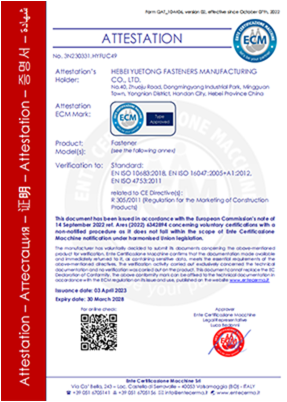Nov . 02, 2024 13:34 Back to list
size of m16 nut
Understanding the Size of M16 Nuts A Comprehensive Overview
The M16 nut is an integral component in various mechanical and structural applications, primarily in automotive and engineering fields. Featuring a metric dimensions that adhere to ISO standards, understanding the specifics of this nut is essential for professionals and enthusiasts alike.
An M16 nut typically corresponds to a bolt that has a nominal diameter of 16 millimeters. It is categorized under the metric system, which is utilized globally in engineering disciplines for standardization. The dimensions of an M16 nut include critical features such as the hexagonal shape, the thread pitch, and the flange type, all of which significantly affect its performance in assembly and structural integrity.
Dimensions and Specifications
The standard dimensions of an M16 nut include a width across the flats (WAF) of approximately 24 mm. The height of the nut generally measures around 10-12 mm, but this can vary slightly depending on the specific grade and design features. The thread pitch for an M16 nut is typically 2.0 mm for coarse threads and can be 1.5 mm for fine threads. This distinction is crucial since it affects compatibility with bolts and the torque specifications during assembly.
Material and Strength Grade
size of m16 nut

M16 nuts are available in a variety of materials, including stainless steel, carbon steel, and brass. The choice of material often depends on the environmental conditions and load requirements of the application. For instance, stainless steel M16 nuts are commonly used in corrosive environments due to their resistance to oxidation and rust. The strength grade—often denoted as 8, 10, or even higher—is an essential factor that determines the nut's load-bearing capacity.
Applications of M16 Nuts
M16 nuts are widely utilized in numerous applications. From securing parts in heavy machinery to connecting elements in construction projects, their robust design ensures stability and safety. In automotive engineering, they play a critical role in fastening engine components, suspension systems, and various chassis applications. The versatility and reliability of M16 nuts make them a preferred choice in many industries.
Conclusion
In conclusion, the M16 nut is a vital element in mechanical assemblies, characterized by its specific dimensions, materials, and application versatility. Understanding the size and specifications of M16 nuts is essential for anyone involved in engineering or mechanical design processes. Whether for industrial use or personal projects, selecting the right M16 nut ensures not only the integrity of the assembly but also contributes to overall safety and performance in mechanical systems. With a solid foundation in the specifics of M16 nuts, professionals can innovate and improve upon existing designs, driving progress in engineering and technology.
-
The Ubiquitous Reach of DIN934 in Application Realms
NewsMay.16,2025
-
Exploring Different Bolt Types
NewsMay.16,2025
-
Cracking the Code of Sleeve Anchor Mastery
NewsMay.16,2025
-
Clamp Design Principles,Types and Innovations
NewsMay.16,2025
-
Artistry Inspired by the Humble Anchor Bolt
NewsMay.16,2025
-
A Deep Dive into Screw Types
NewsMay.16,2025


